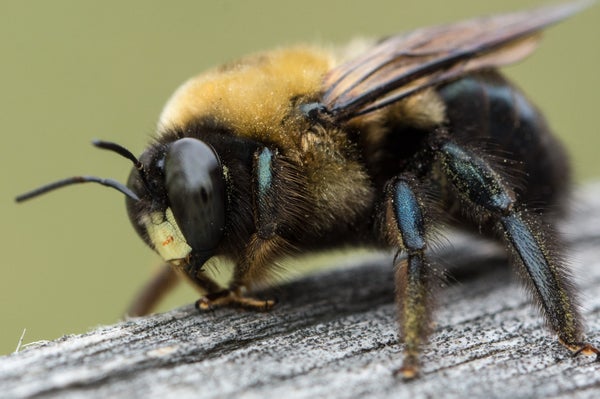Charles Darwin once wrote in his book The Expression of Emotions in Man and Animals that insects “express anger, terror, jealousy and love.” That was in 1872. Now, nearly 150 years later, researchers have discovered more evidence that Darwin might have been onto something. Bumblebees seem to have a “positive emotionlike state,” according to a study published this week in Science. In other words, they may experience something akin to happiness. To some, the idea is still controversial, however.
Unlike humans, you can't simply ask a bee to interrogate its own emotions and describe them. Instead, researchers have to look for evidence that the insects have the cognitive, behavioral and physiological building blocks that, when combined, can give rise to a complex phenomenon like emotion.
Biologist Clint Perry of Queen Mary, University of London devised an experiment to do just that. He and his colleagues trained bumblebees to distinguish between a blue flower placed on the left side of a container and a green one on the right. When the bees explored the blue flower, they found a 30 percent sugar solution. But when they explored the green one, they slurped up plain, unsweetened water. Eventually, the bees learned to associate the blue flower with a tasty reward.
On supporting science journalism
If you're enjoying this article, consider supporting our award-winning journalism by subscribing. By purchasing a subscription you are helping to ensure the future of impactful stories about the discoveries and ideas shaping our world today.
Then the researchers tested the bees on ambiguously colored flowers at intermediate locations. Half of the insects were given a 60 percent sugar solution prior to the test, and those bees flew faster toward the ambiguous blue-green flower. The remaining bees that were not given the sugar flew more slowly.
The assumption that an ambiguous stimulus contains a reward despite the lack of evidence is called an optimism bias. Perry's experiment suggests that a bit of sugar amped up the bees into a positive emotional state, making them more optimistic that the flower would contain a sugary treat.
Sound familiar? Something similar is true in humans—newborn infants cry less if they've been offered a sweet snack, and a bit of candy increases feelings of positivity and improves bad moods in adults, too. “Many of us view the world in a better way when we have a nice piece of dark chocolate,” Perry says.
To be sure that the bees' flying behavior resulted from their underlying emotional state and was not simply a sugar high, the researchers tested the insects on other, unfamiliar flowers in new colors. The effect, Perry says, was specific to flowers with colors that fell somewhere between the blue and green hues they were trained on, not for any other color.
In another test involving a simulated predator attack, the sugar-addled bees showed the same optimism bias. In the wild, bumblebees are sometimes attacked by lurking crab spiders. To mimic such an attack, the researchers gently grabbed the bees with a sponge-tipped mechanical stamp for three seconds before releasing them. The insects that were given sugar water before the “attack” resumed foraging more rapidly than those that weren't, suggesting their positive emotions made them less cautious and more optimistic in this situation as well.
In a final experiment, when the researchers gave the bees a drug that disrupted receptors for dopamine, a neurotransmitter linked with motivation and reward, the bias disappeared, echoing the way this brain chemical works in mammals. “Many scientists, even entomologists, still believe that insects are genetically preprogrammed, rigid, behavioral machines,” Perry says. University of Arizona entomologist Katy Prudic, who was not involved with the study, also disagrees with that idea. “Because they're built so differently, we tend to downplay their emotional states,” she says—“probably because we don't see it in the same way we would with a dog or a cat or a cow.”
There is no intrinsic reason that insects shouldn’t experience emotions. Feelings, on the other hand, are a separate issue. Even though we use the two terms interchangeably in common parlance, scientists use them differently. “Emotions are collections of actions, and numerous species have emoted,” says neuroscientist and philosopher Antonio Damasio of the University of Southern California, “though we can not be certain that they felt their emotings.” In other words, emotions are the body's adaptive response to external events or stimuli. Feelings are the subjective experience of them.
So on receiving bad news, your blood pressure might spike and your respiration rate might plummet. If you saw a mountain lion while hiking, your heart and respiration rates would both increase, your brain would be flooded with cortisol and adrenaline, and your pupils would dilate. These are your body's emotional responses. And they can be, but are not necessarily, coupled with the subjective feelings of sadness or fear, respectively.
The same seems to go for bumblebees, although Perry did not demonstrate that bees have feelings. “We didn't show that they feel happy,” he says. The evidence showed instead that bees possess the cognitive, behavioral and physiological mechanisms that underlie emotions.
“Feeling implies the presence of a mind and a mental experience, [or] consciousness,” Damasio explains. “I have every reason to believe that invertebrates not only have emotions but also the possibility of feeling those emotions.” If insects have feelings, it would have tremendous implications for the way we think about these creatures, including how we attempt to control them as pests.
For now, Perry hopes this research will simply encourage folks to see insects as more than just tiny, unthinking machines.
